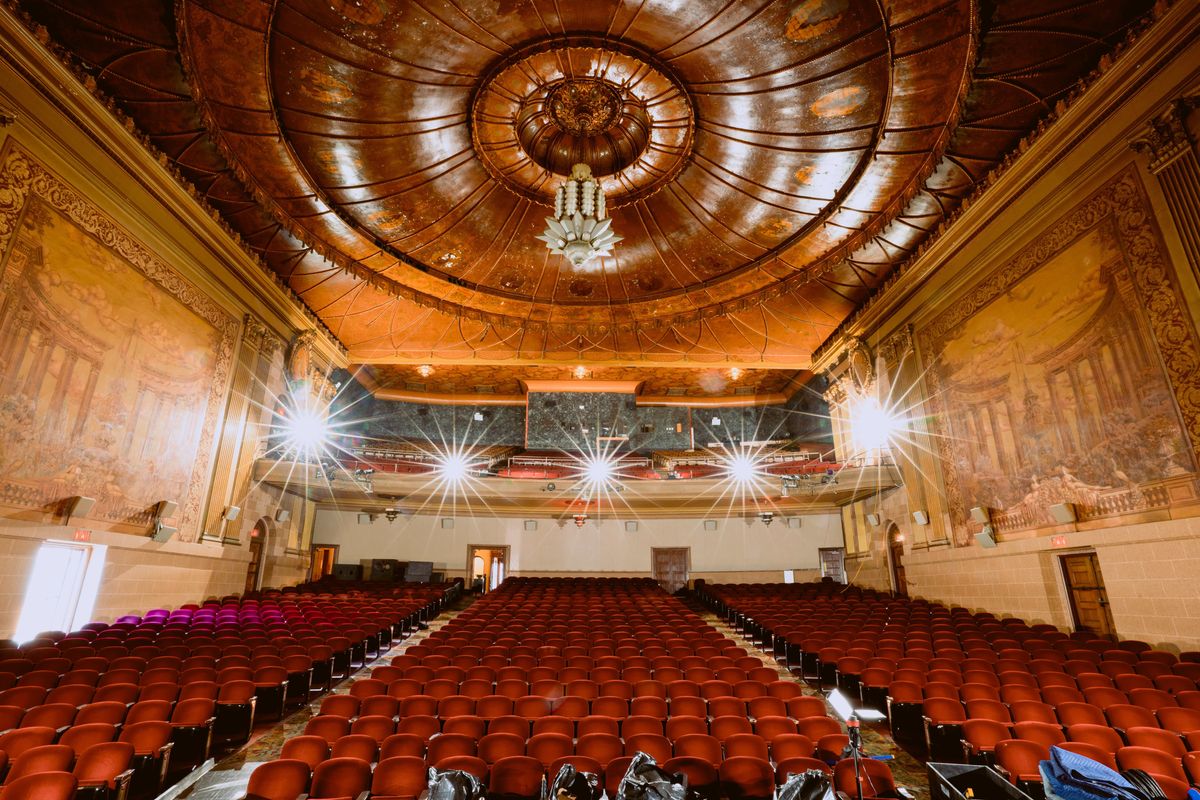In the 1920s and early '30s, a new style of visual arts came into vogue.
Like elsewhere in the U.S. and Europe, San Francisco’s architects and artists fully embraced what would soon become known as Art Deco, a form which incorporated aesthetic beauty and ornamental details into functional spaces like office buildings, restaurants, and theaters.
A hundred years of change have whittled down SF’s Art Deco history into just a handful of locations, but thanks to beautiful restorations and careful stewardship, they remain as enchanting as they were when first designed.
From The Clift Hotel’s Gustav Klimt–kissed Redwood Room to iconic Coit Tower, here are eight of San Francisco’s most memorable Art Deco landmarks.
Redwood Room

(Courtesy of @redwoodroom)
The Redwood Room at The Clift Hotel is as glamorous as it was when it first opened in 1934. As if the texture and grain of redwood paneled walls, classic angular wall sconces, and a massive bar (which, legend has it, was carved from a single 800-year old redwood tree) weren’t Art Deco-y enough, the bar is hung with gold-toned beauties by Austrian master Gustav Klimt. When restored to its original sheen a couple years ago, The Clift also returned the floor to an elaborate black-and-white design inspired by the original, and added sleek banquets and chairs that virtually scream dry martini, straight up. // 495 Geary St. (Lower Nob Hill), redwoodroomsf.com
Thank you to our partners at Clift Royal Sonesta San Francisco.
Castro Theatre

(Courtesy of @the_castro_theatre)
The Castro Theatre is a jewel of San Francisco’s Art Deco era, with its arched and scrolling homage to a Mexican cathedral outside, and wet plaster motif murals and gold-framed mirrors inside. It’s only one of the epic works designed by Timothy L. Pflueger, the famed Bay Area architect also responsible for the stunning 450 Sutter Street skyscraper, Oakland’s Paramount Theatre, and other local landmarks. Today, the iconic marquee and vertical neon sign, both added in the late 1930s, still beckon viewers to the 1,400 seat theater where eclectic programming and a retractable organ have delighted audiences for over a century. // 429 Castro St. (Castro), castrotheatre.com
Cirque Bar at Fairmont San Francisco

(Courtesy of @vintage_san_francisco)
Another Pflueger joint, the Fairmont San Francisco’s Cirque Bar was the first to open in the city after Prohibition’s end in 1933. A vision in gold and blue, the Art Deco space is dominated by golden murals of circus animals painted by the Bruton sisters, tufted gold banquets with navy leather cushions, and a wild carpet of blue spirals and gold leaves. Ninety years after restoring the city’s love affair with (legal) alcohol, the lobby level space today is open only for breakfast. // 950 Mason St. (Nob Hill), fairmont.com/san-francisco
Coit Tower

(Courtesy of @ca.footprints)
Arguably SF’s most famous Art Deco landmark, Coit Tower is 210 feet of elegance and reinforced concrete at the crest of Telegraph Hill. The tapered, fluted design is actually formed from three nested concrete cylinders with an arcaded observation deck at the top. Like at Beach Chalet, the murals painted in the rotunda on the ground floor were a WPA project created by various artists selected to depict different aspects of California life in the early 1930s. // 1 Telegraph Hill Blvd. (North Beach), sfrecpark.org
Beach Chalet Murals

(Courtesy of @beachchalet)
Although the Beach Chalet itself does not have an Art Deco look, the murals on its ground floor are firmly of the era. Created by French artist Lucien Labaudt as a WPA project between 1936 and 1937, the paintings are color-drenched images from four SF tourist attractions: Ocean Beach, Golden Gate Park, Fisherman’s Wharf, and the Marina. The scenes of leisure include some recognizable figures from politics and the arts, likely a commentary on that period of the Great Depression during which activities of relaxation and play would have been out of reach for most. // 1000 Great Hwy (Outer Sunset), beachchalet.com
MUNI F Line

(Courtesy of @okeefebrian)
SF’s transit system may be best known for having the world’s last manually-operated cable car service but it is also the place of one of the city’s most accessible Art Deco landmarks. In 1995, the street cars on MUNI’s F-line, a route which has been running Market Street since 1860, permanently welcomed around two dozen vintage Peter Witt-style trams built in the 1920s. Painted in bright color schemes to represent great cities of North America, the F-line’s streetcars still recall those halcyon days when public transportation was still allowed to be beautiful. // sfmta.com
Aub Zam Zam

(Courtesy of @zamzambarsf)
Although it dates to 1941, a few years after Art Deco’s peak, Aub Zam Zam is no less enticing than the few other remaining bars and restaurants of the era. Opened and ruled by Assyrian-born Bruno Mooshei until his passing in 2000, this Haight Street watering hole has a circular bar that glows against a Middle Eastern-inspired mural that depicts the love story of Princess Shrin and King Khosrow. With its red-toned walls, vintage cash register, and kick-ass martinis, the early 20th-century ambiance here is as good as it gets. // 1633 Haight St. (Haight-Ashbury), yelp.com
Schroeder’s

(Courtsey of @schroederssf)
Technically, Schroeder’s, the Financial District’s Bavarian-inspired beer hall, pre-dates the Art Deco era. But when the restaurant was destroyed in the 1906 earthquake and fire, and reopened downtown on Front Street, it acquired the look to which it was recently restored. Like an elite mens’ hunting lodge (women weren’t even allowed to enter until the 1970s), Schroeder’s sports a dark, wood-paneled bar, taxidermied busts, and expansive murals of German decadence. // 240 Front St. (Financial District), schroederssf.com





















